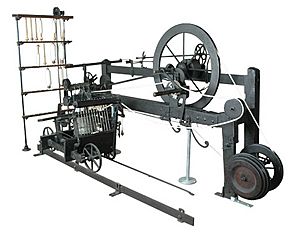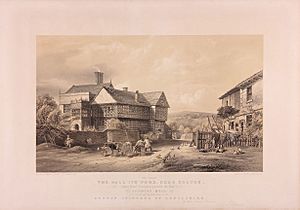Samuel Crompton facts for kids
Quick facts for kids
Samuel Crompton
|
|
|---|---|

c.1800 by Charles Allingham (1788–1850)
|
|
| Born | 3 December 1753 |
| Died | 26 June 1827 (aged 73) 17 King Street, Bolton, Lancashire, England
|
| Resting place | St Peter's Church, Bolton, Lancashire, England |
| Nationality | English |
| Occupation | Inventor, pioneer of the spinning industry |
| Known for | Spinning mule |
| Signature | |
Samuel Crompton (born December 3, 1753 – died June 26, 1827) was a brilliant English inventor. He became a key figure in the early Industrial Revolution by creating a machine that changed how cloth was made around the world. This invention, called the spinning mule, built upon earlier ideas and made spinning yarn much faster and better.
Contents
Samuel Crompton: Inventor of the Spinning Mule
Early Life and Inspiration
Samuel Crompton was born in a place called Firwood Fold, near Bolton in Lancashire, England. His parents were George and Betty Crompton. His father worked as a caretaker at a nearby estate called Hall i' th' Wood. Samuel also had two younger sisters.
When Samuel was still a boy, his father passed away. This meant Samuel had to help his family earn money. He learned to spin yarn, which is thread used to make fabric. He used a machine called a spinning jenny. However, Samuel noticed that the spinning jenny had some problems. It didn't always make the best quality yarn.
This experience gave him an idea: he wanted to invent a better machine. He worked on his secret project for about five or six years. It took up all his free time and money. To earn extra cash, he even played the violin at the Bolton theatre.
On February 16, 1780, Samuel Crompton married Mary Pimlott. They had eight children together. Their son, George Crompton, later followed in the family's footsteps, working in the textile business.
The Amazing Spinning Mule
Around 1779, Samuel Crompton finally succeeded in building his new machine. He called it the "mule-jenny." People also knew it as the muslin wheel or the Hall i' th' Woodwheel, named after the house where he lived. This machine was amazing because it could spin yarn that was perfect for making muslin, a very fine and delicate fabric.

There was a huge demand for the high-quality yarn Crompton was making. However, he didn't have enough money to get a patent. A patent is a special legal right that protects an inventor's idea, so others can't copy it without permission. People started trying to figure out how his machine worked. Because he couldn't protect his invention, Crompton had to choose: either destroy his machine or share it with everyone.
He decided to share it after some manufacturers promised to pay him for using his invention. But these payments didn't always happen as promised. Samuel went back to spinning yarn on his own, but he didn't have much success.
The spinning mule was special because it combined the best parts of two earlier machines. It used rollers to twist the rovings (strands of fiber) like one machine. Then, a moving part with spindles (rods that hold and twist thread) stretched the thread and gathered it, similar to another machine. This clever design allowed the mule to spin much finer and stronger thread than could be made by hand. For example, coarse thread might sell for 14 shillings per pound, but the fine thread (called 80s count) from his mule sold for 42 shillings a pound!

Since Crompton's machine wasn't patented, other people quickly started building their own versions. Over time, the machine was improved. It was made with iron, and power was added to help it work. By 1834, it could even run almost completely by itself! By 1812, a survey showed that between 4 and 5 million spinning mule spindles were being used. Sadly, Samuel Crompton never received any royalties (payments for the use of his invention) for its widespread success.
A Legacy of Innovation
In 1800, a group of people raised £500 to help Samuel Crompton. Later, in 1809, another inventor named Edmund Cartwright received a large sum of £10,000 from the government for his invention. This inspired Crompton to ask for a grant too.
In 1811, he traveled around the manufacturing areas of Lancashire and Scotland. He collected proof to show how widely his spinning mule was being used. In 1812, the government awarded him £5000.
With this money, Crompton tried to start several businesses. He worked as a bleacher (someone who whitens fabric) and then as a cotton merchant and spinner. However, these businesses were not successful. In 1824, some friends and members of a local club in Bolton bought him an annuity. This was a regular payment of £63 each year, which they arranged without him knowing. It helped him financially in his later years.
Samuel Crompton passed away at his home in King Street, Bolton, on June 26, 1827. He was buried at St Peter's parish church. His invention, the spinning mule, forever changed the textile industry and played a huge role in the Industrial Revolution.
See also
 In Spanish: Samuel Crompton para niños
In Spanish: Samuel Crompton para niños

